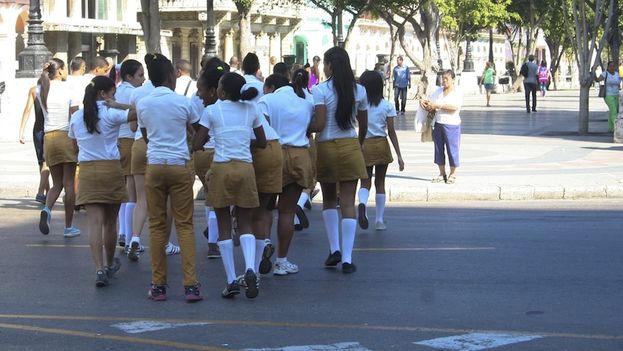
The sale of school uniforms started in Pinar del Rio this morning, a moment eagerly awaited by parents and students at different levels of education where the satisfaction of having a new outfit mixes with the frustrations of long lines and the problems with sizes.
A few days ago the Ministry of Education and the Ministry Domestic Trade reported that the pennant will be raised for the sale of uniforms on Wednesday. Unlike other years, this time the sales haven’t started in the capital. The provinces of Ciego de Ávila, Villa Clara, Guantánamo and Pinar del Río are leading off and the other regions of the country will be added throughout the month of June.
The news wouldn’t be significant if it weren’t that in recent decades the purchase of school uniforms has been an agonizing process for Cuban families. The national newspapers are obliged to publish a schedule of the sales and the rules governing them: a voucher with the student’s name, their town, province, school, gender and grade, authorizes the purchase of a school uniform.
Even the central store, La Capitana on Maximo Gomez Street, has come to 14ymedio to learn people’s opinions. Some two hundred mothers and grandmothers, as confirmed by this newspaper, are outside and inside the store. The line started forming yesterday afternoon.
The uniform for elementary school costs 9 Cuban pesos (CUP), and can be bought by students in the first, second, third, fourth and sixth grades, or those starting this level; while the junior high uniform costs 22.50 CUP for boys and 15.50 for girls. This year they’ve extended the possibility to grades that previously didn’t receive the so-called “uniform voucher.”
A similar policy was followed for junior high, high school and other educational levels.
Migdalia Herrera, with an eight-year-old son in elementary school, says she’s been there since last night. “I don’t want what happened in other years, when the medium sizes didn’t come, and I had to alter the shirt and the shorts,” she said. The main complaint of those who have already purchased uniforms is centered on the availability of “too few sizes for small or thin children.”
Another seller, The Sensation on Martí Street, also in Pinar del Rio, came to 14ymedio to ask about the “problem with sizes.” Assuncion Valdez has twin granddaughters who are starting in kindergarten. “Fortunately, I’m a good seamstress, because these skirts need to be taken in a lot at the sides,” she says while showing the uniforms she’d already bought.
The parallel path
Outside the stores where they’re selling the uniforms are resellers. A blouse for junior high students costs around 50 CUP in this informal market, almost ten times the price in the subsidized market. Many parents are forced to buy illegally because the school uniforms wear out or their teenage children grow too fast.
Not only reselling helps alleviate the shortage of uniforms; a new phenomenon is expanding: importing these garments made abroad. Given the high demand on the island, some stores located in Miami, Florida offer almost identical – and better quality – copies of Cuban school uniforms. “My daughter said to me, ‘Mommy, I want a new uniform,’ and I have to ask my sister who lives in the North,” says Lilian Herrera, with a daughter in the third grade.
Similar scenes and comments are being repeated today in Ciego de Ávila, Villa Clara and Guantánamo.
